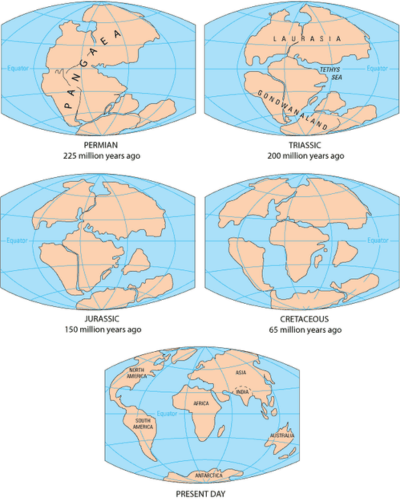In the early 20th century, Alfred Wegener proposed a revolutionary theory that the continents were once joined together in a single supercontinent and later drifted apart over millions of years. This theory came to be known as continental drift. Wegener noticed that the coastlines of some continents seemed to fit together like pieces of a jigsaw puzzle. He also found fossil evidence of similar plants and animals in continents now far apart, suggesting they were once connected. Additionally, he pointed to geological formations that matched up across oceans. Though Wegener’s ideas were initially met with skepticism, they paved the way for the later theory of plate tectonics.
Alfred Wegener was a German polar researcher, geophysicist and meteorologist. Born in Berlin in 1880, he obtained his doctorate in astronomy from the University of Berlin in 1904. Fascinated by Greenland, he took part in four expeditions to the Arctic island to study polar weather from 1906 to 1908. During his treks across the rugged, icy landscape, Wegener noticed similarities between the coastlines of Greenland and Europe, sparking his theory of continental drift.
Apart from his Arctic explorations, Wegener had an adventurous spirit and diverse interests. He was involved in several scientific disciplines like meteorology, geophysics and paleoclimatology. He served in the German army during World War I. Tragically, Wegener died during his last expedition to Greenland in 1930 at just 50 years old. He was survived by his wife, Else Köppen, who was the daughter of his mentor, meteorologist Wladimir Köppen. Continental drift became Wegener’s major scientific obsession for the last two decades of his life.

Alfred Wegener’s radical theory of continental drift was initially met with skepticism and hostility from the geological establishment. At the time, scientists believed continents and oceans were fixed in place, an idea known as permanence. Wegener’s proposals directly contradicted this accepted view. He defended his controversial hypothesis in publications, lectures and conferences. However, his meticulous compilation of evidence such as gathering fossil evidence of similar species were found on separate continents. For example, fossils of the extinct fern Glossopteris were located in South America, Africa, India, Australia and Antarctica.
Additionally, identical rock formations and geological structures occurred on different continents. For instance, a distinctive belt of ancient mountains made of folds and faults called the Appalachians can be traced from North America to Europe. The formations match so closely that they appear to be disconnected pieces of the same mountain range. This would make sense if the landmasses were once adjoining.
Climate clues also backed up Wegener’s theory. He found evidence of tropical plant fossils and extinct reptiles that could not have lived in the icy climates of some continents where their traces were found. The Permian reptile Mesosaurus has been discovered only in South America and southern Africa, indicating the two continents were previously in warmer proximity.
Wegener also pointed to polar wandering, changes in Earth’s rotational axis relative to its surface over time. This could have made different regions shift between climate zones, explaining the presence of tropical fossils in polar regions. He studied changing positions of the continents’ poles relative to their current locations.
Furthermore, he consulted and collaborated with experts worldwide. He used paleontology, geology, climatology and cartography to make his case. Critically, Wegener had to propose a mechanism for how solid continents could plow through Earth’s crust. He hypothesized they moved through the ocean floor, but could not work out how. This gap allowed opponents to dismiss his theory as physically impossible.
While rejection of his ideas caused difficulties at first, Wegener’s bold theorizing ultimately propelled his theory to be widely accepted around the 1950s and 60s, His painstaking data gathering, creative interdisciplinary thinking, and willingness to challenge orthodoxy paved the way for the acceptance of continental movement. This led to the pivotal theory of plate tectonics in the 1960s. Wegener’s thought experiment exemplifies the immense power of bold scientific conjecture. His story remains an inspiration for pioneering researchers across disciplines to also imaginatively synthesize data from multiple specialties to transcend entrenched dogma with groundbreaking hypotheses.
Alfred Wegener is now recognized as a revolutionary thinker who pioneered the field of tectonics. The elegance of his continental drift theory and its wide-ranging evidence fundamentally transformed geology. Today he is hailed as one the most influential Earth scientists of the 20th century. Wegener’s willingness to challenge orthodoxy with creative thinking is a model for paradigm-shifting scientific work.

From the icy fields of Greenland to the halls of greatness in academia, Alfred Wegener’s journey is a perfect example for modern-day researchers that face the challenges of scientific skepticism that often accompany groundbreaking ideas.
In the face of adversity, Wegener’s determination was unwavering. He was met with mockery and his concepts were dismissed as implausible, yet he persisted and prevailed. Today’s researchers can draw inspiration from his resilience as Wegener’s approach emphasizes the importance of perseverance, meticulous data collection, and interdisciplinary collaboration.
Skepticism is an inherent part of the scientific process. It serves as a check and balance, ensuring that theories are rigorously tested and refined. However, it’s crucial to differentiate between constructive skepticism, which seeks to understand and validate, and dismissive skepticism, which outright rejects without proper consideration. Wegener faced the latter, a resistance to change established beliefs that were deeply rooted throughout the world. Modern researchers will more than likely encounter a similar resistance, especially when their concepts challenge long-held paradigms.
To navigate this, researchers can adopt a few strategies inspired by Wegener’s journey:
Interdisciplinary Collaboration: Just as Wegener drew from paleontology, geology, and climatology, today’s researchers can benefit from collaborating across disciplines. Such collaborations can offer fresh perspectives, validate findings, and provide a more organic understanding of complex problems.
Meticulous Data Collection: Wegener’s extensive evidence collection was instrumental in eventually gaining acceptance for his theory. In the face of skepticism, robust and comprehensive data can be a researcher’s strongest ally. You must strive to provide undeniable evidence that makes it difficult for a scientist to dismiss.
Effective Communication: It’s not enough to have a revolutionary idea, one must also be able to communicate it effectively. By presenting findings in a clear, accessible manner and being open to feedback, researchers can gain support for their theories. In today’s arena, presentations and even videos are effective tools that complement and gain exposure to their published paper.
Resilience in the Face of Adversity: Wegener’s story is a testament to the power of belief in one’s convictions. Researchers must be prepared for initial skepticism and rejection. However, with a combination of determination, continuous learning, and adaptability, they can navigate these challenges.
Alfred Wegener’s legacy serves as a powerful reminder of the transformative potential of innovative thinking. His journey that began from simple observations, to a thought process, to years of hard work, to the trials and tribulations that often accompany paradigm-shifting ideas, is a story that offers both a course of caution and a source of inspiration. In the ever-evolving landscape of the scientific community, it’s crucial to remain open-minded, to question, to collaborate, and most importantly, to persevere. As we stand on the shoulders of giants like Wegener, let’s remember that the path to significant theories and discoveries is often faced with challenges, but with determination and a relentless pursuit, the impossible can become the new standard.






